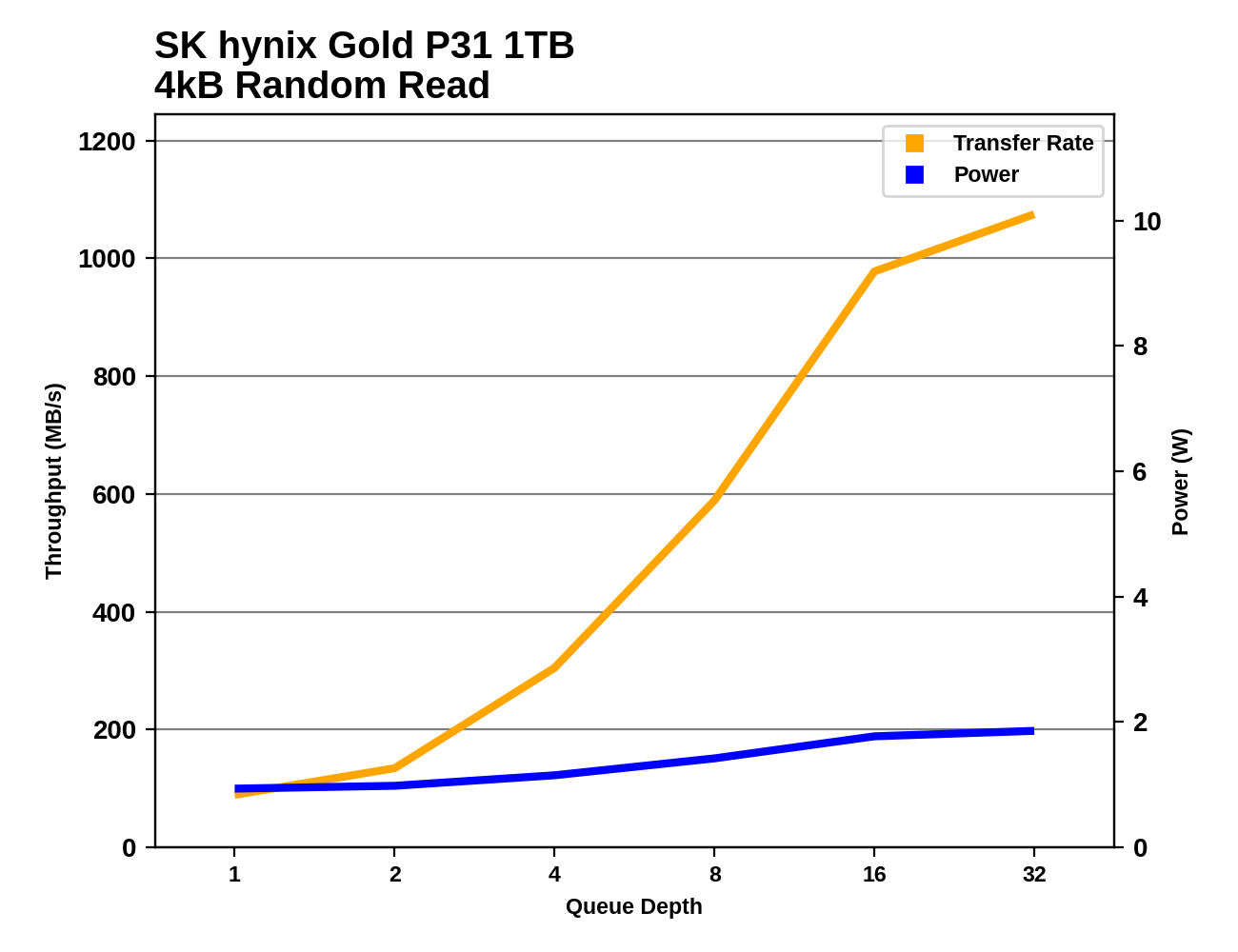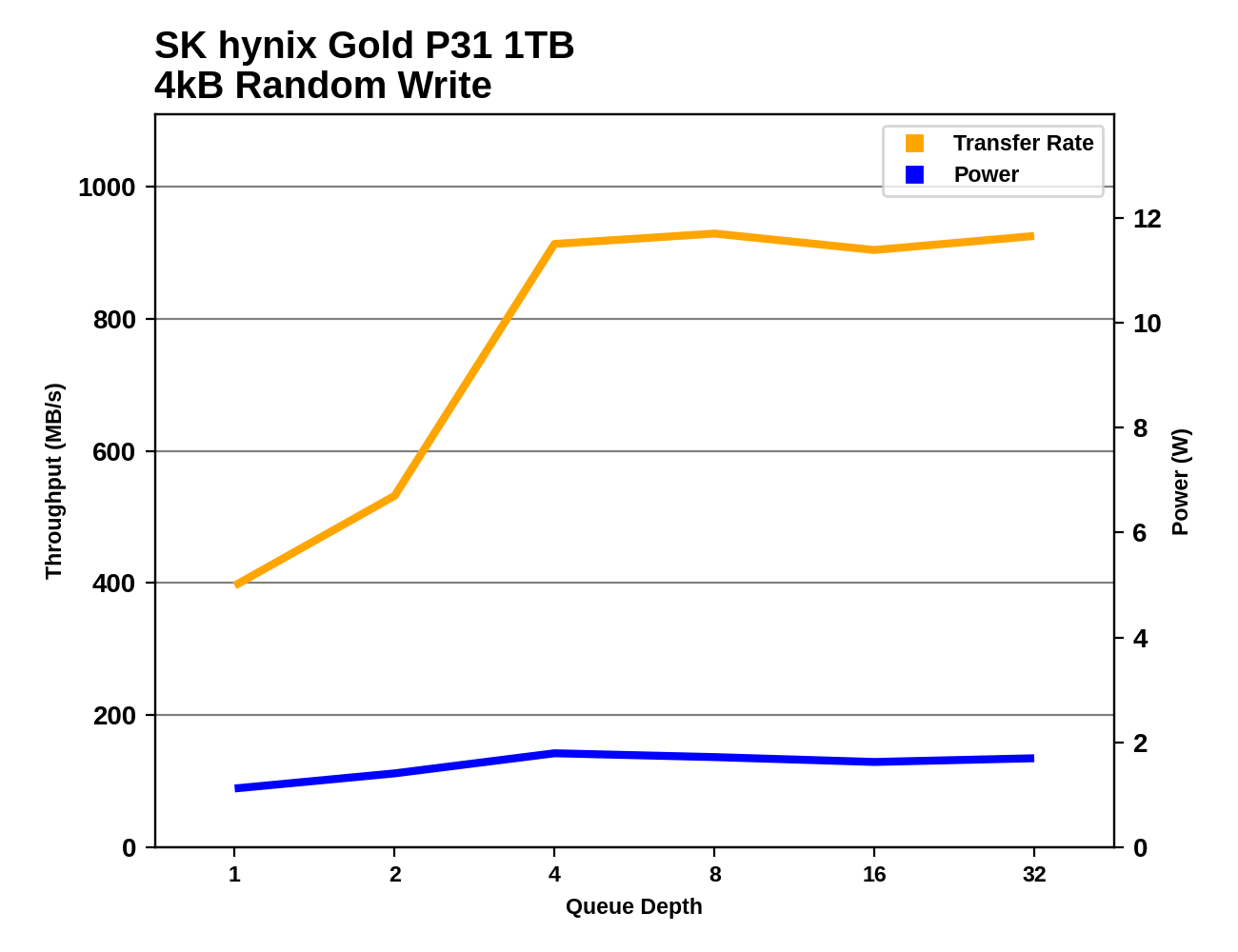The Best NVMe SSD for Laptops and Notebooks: SK hynix Gold P31 1TB SSD Reviewed
by Billy Tallis on August 27, 2020 8:00 AM ESTRandom Read Performance
Our first test of random read performance uses very short bursts of operations issued one at a time with no queuing. The drives are given enough idle time between bursts to yield an overall duty cycle of 20%, so thermal throttling is impossible. Each burst consists of a total of 32MB of 4kB random reads, from a 16GB span of the disk. The total data read is 1GB.

The QD1 burst random read performance of the SK hynix Gold P31 is similar to what we see from drives using the Silicon Motion SM2262EN controller, which has dominated this test since it hit the market.
Our sustained random read performance is similar to the random read test from our 2015 test suite: queue depths from 1 to 32 are tested, and the average performance and power efficiency across QD1, QD2 and QD4 are reported as the primary scores. Each queue depth is tested for one minute or 32GB of data transferred, whichever is shorter. After each queue depth is tested, the drive is given up to one minute to cool off so that the higher queue depths are unlikely to be affected by accumulated heat build-up. The individual read operations are again 4kB, and cover a 64GB span of the drive.

On the longer random read test that reaches into higher queue depths, the Gold P31 pulls narrowly ahead of the SX8200 Pro to set a new record for TLC-based SSDs.
 |
|||||||||
| Power Efficiency in MB/s/W | Average Power in W | ||||||||
The power draw of the Gold P31 is only a hair above that of its SATA sibling, the Gold S31. But the P31 is delivering almost three times the performance of that drive, and twice the performance per Watt of the next most efficient drive.
 |
|||||||||
The Gold P31 delivers class-leading performance across the entire range of queue depths covered by this test. Its performance is starting to taper off by QD32, but at that point it has caught up with the throughput of the Optane 905P. The widest margins over other TLC SSDs are around QD8 through QD16. Power consumption remains very low throughout the test, not even reaching 2W at QD32 - that 2x efficiency advantage over the competition remains just as true at high queue depths.
Plotting the P31's results against the entire benchmark database shows that the P31 stakes out new territory. The closest competition on the power/performance landscape are the tiny Intel Optane Memory M.2 drives, and at QD4 or higher all the other flash-based SSDs need considerably more power to deliver the same performance (at QD4 and below, the P31 is still in SATA performance territory where there are more low-power competitors).
Random Write Performance
Our test of random write burst performance is structured similarly to the random read burst test, but each burst is only 4MB and the total test length is 128MB. The 4kB random write operations are distributed over a 16GB span of the drive, and the operations are issued one at a time with no queuing.

The burst random write performance of the Gold P31 is lackluster: slower than most high-end NVMe drives, though actually still a bit faster than the Samsung 970 EVO Plus.
As with the sustained random read test, our sustained 4kB random write test runs for up to one minute or 32GB per queue depth, covering a 64GB span of the drive and giving the drive up to 1 minute of idle time between queue depths to allow for write caches to be flushed and for the drive to cool down.

On the longer random write test that includes some higher queue depths, the high-end NVMe drives mostly have fairly similar scores, and the P31 falls in the middle of the pack for performance.
 |
|||||||||
| Power Efficiency in MB/s/W | Average Power in W | ||||||||
Once again, the power consumption of the Gold P31 is more in line with low-power SATA or DRAMless NVMe drives, even though it offers high-end performance. This time, the efficiency score isn't quite twice that of the next best competitor, but a 75% improvement is still impressive.
 |
|||||||||
The performance profile for the Gold P31 on the random write test is fairly typical: fill performance is reached at QD4, and performance is mostly steady through the rest of the test. The P31 starts out slightly slower at QD1, but at full speed it is definitely competitive.
Comparing the Gold P31's random write performance against our entire database of results shows it standing out even more clearly than it did for the random read results. The QD1 random write performance is already beyond the reach of SATA drives, and none of the other NVMe drives we've tested operate at such low power levels.












80 Comments
View All Comments
ballsystemlord - Thursday, August 27, 2020 - link
@Billy Thanks for the review. There have been several new SSD releases this year. I look forward to more SSD articles!ballsystemlord - Thursday, August 27, 2020 - link
Of course, I'm assuming manufacturers are sampling you guys. (:serendip - Thursday, August 27, 2020 - link
There needs to be more options for 2230 and 2242 drives. More laptops are coming out with replaceable drives in those smaller form factors.Samus - Friday, August 28, 2020 - link
Kinda feel stupid for buying an SN750 a few weeks ago...vladx - Friday, August 28, 2020 - link
Still an excellent drive, a bit pricey though...cfbcfb - Sunday, August 30, 2020 - link
Just installed one in my desktop t replace an older Hynix OEM 256GB drive.Zero issues cloning, I used Macrium to "backup everything needed for windows" to another drive, made a usb stick with standalone macrium, put in the p31 and booted from the usb, restored the image and I was off and running.
Stunning speed for the price, especially the write speed. In some instances I'm seeing faster writes than reads. And hey, power savings and less heat from a non heatsink nvme drive is okay in a desktop too! That's one of the reasons why I got it. With most other high end drives you need a heatsink unless you have a fan blowing on it, and in my system the m.2 slot is right next to the gpu in the only x16 slot, and the nearest fan is the cpu heatsink fan.
So my old drive would often hit 60-80c. No bueno. This one? After hammering it, its still barely warmer than ambient case temp. Plus its one sided, which is nice.
A WD 750 black with heatsink or an 8200 pro with heatsink are MUCH more expensive.
This is a MSRP deal of the year for nvme high end drives. Durability and warranty are also excellent.
So its not just for laptops. Don't hesitate to buy this drive if you want a high end nvme SSD in ANY device.
nfriedly - Monday, August 31, 2020 - link
Is the Gold P31 a single-sided drive or a double-sided drive? (In other words does it have any components on the bottom?) There are a few smaller laptops, such as the GPD Win Max, that only have room for single-sided drives.Srikzquest - Wednesday, October 14, 2020 - link
This one is a single sided drive, that's a plus against ADATA's XPG 8200 Pro.AnarchoPrimitiv - Monday, August 31, 2020 - link
I'll hold back on calling it a "fantastic laptop drive" until it's actually put in a laptop with battery duration tests performed and compared to other drives. If it's power savings only equate to 15 extra minutes of battery in real life for example, then it's definitely not worth the compromise on performances.Srikzquest - Wednesday, October 14, 2020 - link
That's the point, there is hardly any compromise with performance. Its equally good on Efficiency and Performance.